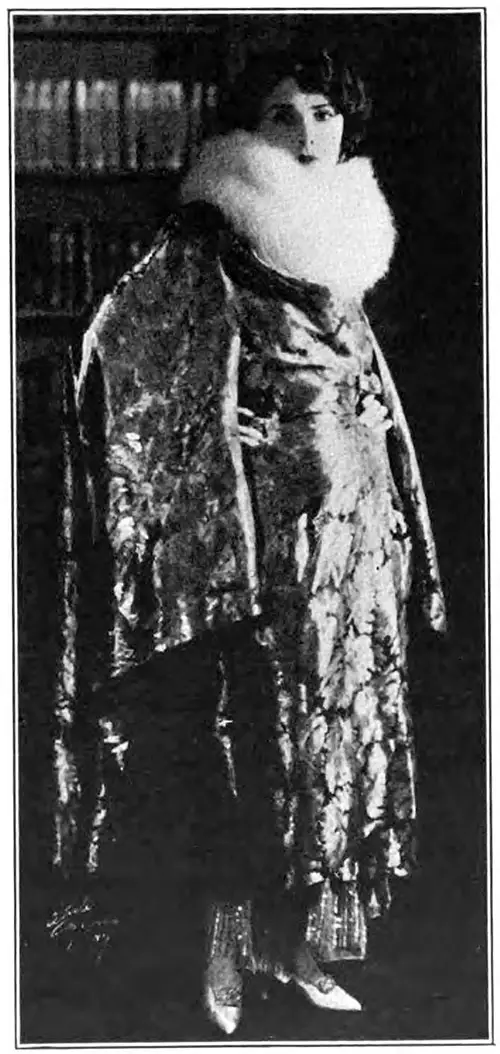The Resurgence of Fur Coats and Capes Seen 1922
The Fur-Trimmed Coat and a Word as to Neckpieces.
The possibilities of the sports coats of practical furs are but just beginning to be realized, in the opinion of those who watch consumer developments.
It is because of the marked increase of the knee-length and hip-length coat of muskrat, raccoon and the hard-wearing skunk trimmed caracul, worn above a simple tailored suit, that the liking for the combination is said to be leading to style developments hitherto but half encouraged.
The appearance of a brilliant woman at the Plaza at the tea hour in an otter coat with a four-inch edge of seal skin following its odd square cut lines, worn above a smart tailor of black broadcloth, gave this idea an added significance.
As she wore the otter coat, the effect was formal and luxurious, completing the suggestion that with the possibly extended advance of the suit the top coat of fur in this short, crisp silhouette may reach new experimentation.
Another point demonstrated in the past few months is the general acceptance of the squirrel pelt, flat and visibly overlapping in horizontal lines of the box coat.
There was a noticeably increased interest in the platinum caracul ripple back coats, and of the noisette brown and warm beige-brown shades, the latter usually observed on a youthful cut noted throughout January.
Nevertheless, there was also a marked increase in beige and tan cloth "coats of elegance," collared, cuffed and bordered in the dyed caraculs.
Interest in fitch from month to month arrived at its climax with the appearance of fitch capes, the pelts handled in the new striping methods and revealing most exciting possibilities.
One example noted at Sherry's was in a great circle, the pelts radiating from a dark disc at center back. Fitch, in combination with saffron kasha, was a much-observed coat of French tendencies seen on the Avenue in January.
Capes
Fur capes may be said to have achieved two distinct successes.
The short mode of a curving downward back line not far below the hips was often seen, while a long cape in squirrel, beaver, seal broadtail, caracul and Persian lamb came forward in most striking types, as observed at the luncheon and tea hour in various hotels.
The great interest taken by those recently returning from France in the exquisite new biscuit shade of perllaine, raillaine, kasha and other new textures, was demonstrated particularly well by the appearance of a most striking woman of Russian appearance in a noticeably Russian type of costume.
She wore a cape of the biscuit shade of perllaine with a large chin-chin collar of most beautiful sable standing out on the shoulders very wide and high, with a decorative line of tails dropping each side of the front to the bust line.

Revival of Interest in White Fox
Bendel creates for Miss Mary Nash a superb flame and gold brocade wrap collared in while fox
There were deep sable cuffs on the arm slits of the cape, and the coronet toque was of sable. The different make-up, dark hair, striking costume and arresting carriage of this stranger in our midst made her entrance to the Plaza dining-room quite sensational.
Sable, incidentally, has been worn more often by the younger women this year than ever before; nevertheless, in combining it with cloth, it becomes for the first time a jeune fille fur legitimately, its tradition placing it with the mature carriage of impressive women.
Evening Cloaks
The ermine cape combined with seal skin sable and the French fad, skunk, has dramatically increased in its public appearances with the progress of the season.
The model which was seen on many smart women in January was the close line cape of shallow yoke with slight fullness below and the chin-chin or pouf collar, the latter varied on type being seen occasionally on the double pouf or ruff type, but this collar was, apparently, considered very be coming in its soft informality of lines against the face.
The cloth of silver cloak lined with fur was noted in a striking model seen at the Ambassador Hotel, with a thick border and lining of sealskin, no fur appearing near the face.
The velvets brocaded in lame were also noted as showing no outer intimation of fur, but lined with ermine or white caracul, and thus reversing the fur cloak lined with velvet.
It would seem considerable favor this season had been extended toward the art tones of blue velvet with collar and cuffs of chinchilla.
The blues varied from Wedgewood to sapphire but were seen in many variations during December and January, the months when the scarlet cloaks began to descend upon New York's evening hours in many illustrations of the success of these gay and youthful wraps.
Neckpieces for Spring
There is a substantial rise of interest in the white fox as a collar for the brocade wrap of the later season. So much development appears of late in theatre wraps that it may be in line for a neck scarf revival for Spring.
Otherwise, the grey, taupe, blue and silver fox will reign, possibly the red fox now worn in Paris, with the one and two-animal scarfs featured in Sable, and Stone and Baum Marten.
“A Resume of Fur Coats and Capes Seen in January: The Fur-Trimmed Coat and a Word as to Neckpieces,” in The American Cloak and Suit Review: Devoted to the Women’s and Children’s Ready-to-Wear Trades, New York: John M. O’Connor & Co., Vol. XXIII, No. 2, February 1922, p. 146, 148.
Note: We have edited this text to correct grammatical errors and improve word choice to clarify the article for today’s readers. Changes made are typically minor, and we often left passive text “as is.” Those who need to quote the article directly should verify any changes by reviewing the original material.
